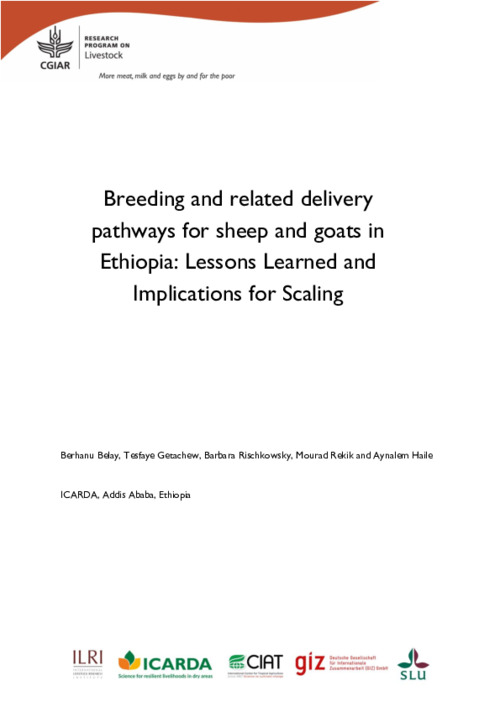Breeding and related delivery pathways for sheep and goats in Ethiopia: Lessons Learned and Implications for Scaling
Abstract
Small ruminant production is part of the livestock production system that contributes 
to food security and livelihoods for the smallholder farmers and pastoralists and one 
of the main foreign exchange earners for Ethiopia (Gizaw et al., 2013). There were a
number of efforts in improving the productivity of the indigenous livestock through 
various intervention strategies that are mainly based on external inputs in terms of 
genetic material introduction, forage development and disease control practices that 
did not respond to the amount of input introduced in the subsistence and resource 
poor farming situation (Workneh et al., 2003). 
Genetic improvement efforts targeting smallholder production systems are 
constrained by small animal numbers per household, single-sire flocks, lack of 
systematic animal identification, absence of performance and pedigree recording, 
illiteracy, poor infrastructure and ill-functioning public institutions (Mirkena et al., 2012). 
Crossbreeding and on-station selective breeding was initiated in 1960 and 1980, 
respectively and CBBP was initiated in 2010 in Ethiopia. CBBP, a more participatory 
approach started gaining global interest (Mueller et al., 2015. This approach is 
inherently sustainable as it supports local-level decision making, focuses on locally 
adapted indigenous breeds, considers the constraints that smallholder farmers face 
and empowers farmers’ organizations (cooperatives) in low input systems (Mueller et 
el., 2015). The expansion of CBBP in a number of villages and the persistence of 
CBBP over 12 years is indicator of the sustainability of the program. The sustainability 
of the program is emanated from affordability and simplicity of the program that 
included farmer’s participation, capturing indigenous knowledge, market outlets and 
4
skill incentives and a continuous capacity building at each stage. Ethiopia recognized 
community‐based breeding programs as the strategy of choice reflected in national 
livestock master plan.
The result of CBBP embraces social cohesion, increase productivity, improvement in 
farmers’ income and genetic conservation through improvement and utilization. CBBP 
goes beyond genetic and productivity improvements and includes hastening village 
social affinity and cohesion. The social network plays major role and serve as entry 
point in sharing of breeding rams and advance CBBP. 
The increase in litter size, combined with the increased 6-month body weight, has 
contributed to the increased in income by 20% and farm-level meat consumption has 
also increased from one sheep per year to three per year slaughter (Haile et al., 2019). 
CBBP recognizes proper, feasible and robust delivery pathway for improved genetics 
in the planning process. The delivery pathway focuses on proper distribution of the 
improved genetics and utilization of reproductive technologies to maximize the 
utilization of improved sires. It was noted that, under natural mating in a period of 20 
years, the genetic progress for six months weight was 3.6 kg and with inclusion of AI 
the genetic progress can reach up to 4.5 kg during the same period, however, the 
genetic dissemination due to AI implies the increase in cost. 
There are good opportunities to advance CBBP and improve the livelihood of resource 
poor and small holder farmers. The CBBP is run based on local inputs such us 
indigenous breeds and under farmers setting. The huge number of core population, 
the number of breeds characterized for genetic improvement and the demand created 
to buy improved rams is opportunity to advance CBBP. The breeding program and 
methodology has been tested and adjusted over 12 years, the communication 
5
channels between stakeholders are working and positive results are already 
documented that will pave the way to advance CBBP. A simple guideline for setting 
up community based small ruminant breeding program has been developed for a wider 
use and circulation and utilization that will create opportunity to scale up CBBP 
initiatives. 
There are good lessons accumulated over 12 years of the project. The project has
developed a robust tool to set breeding objectives; demonstrated a breeding strategy 
in a small flock; there is in-built capacity building and monitoring and evaluation; the 
selection has been shifted from phenotypic ranking to breeding value through farm
level performance recording for decision making; delivery pathways are diversified in 
CBBP. In sum, CBBP is proved to be sustainable and affordable that fits very well 
under small holder farmers setting that, requires a strong commitment to scale up/ out
by engaging various stakeholders

